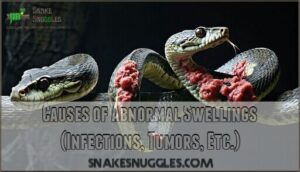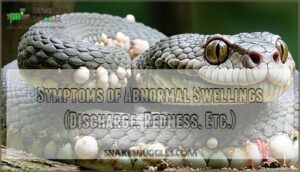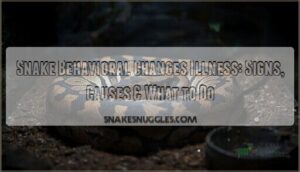This site is supported by our readers. We may earn a commission, at no cost to you, if you purchase through links.
 When your snake has a depressed immune system, you’ll notice warning signs like lethargy, loss of appetite, and respiratory issues.
When your snake has a depressed immune system, you’ll notice warning signs like lethargy, loss of appetite, and respiratory issues.
Poor husbandry often triggers these problems – think incorrect temperatures, high humidity, or dirty enclosures. Stress from excessive handling or loud environments also weakens their defenses.
You can boost their immunity by maintaining proper heat gradients, providing clean water, and creating hiding spots for security. Regular vet checkups catch issues early, while quarantining new snakes prevents disease spread.
The key is consistency in care routines. Understanding specific symptoms and targeted treatments can mean the difference between a thriving snake and ongoing health struggles, which is why regular vet checkups and proper heat gradients are crucial for a snake’s well-being, and ultimately lead to a thriving snake.
Table Of Contents
- Key Takeaways
- Signs of a Depressed Immune System
- Common Health Issues in Snakes
- Inclusion Body Disease (IBD) in Snakes
- Respiratory Infections in Snakes
- How to Boost Your Snake’s Immune System
- Salmonella and Snakes
- Abnormal Swellings and Masses in Snakes
- Difficulty Shedding in Snakes
- Burns and Bites in Snakes
- Emergency Care for Snakes
- Frequently Asked Questions (FAQs)
- How does stress affect a snake?
- Are snakes prone to health problems?
- How do Snakes get sick?
- What are the signs of illness in snakes?
- Why is respiratory health important for snakes?
- What happens if a snake’s respiratory system is compromised?
- How can I tell if my snake is sick?
- What are some specific symptoms of common illnesses in snakes?
- Why is shedding a concern for snake health?
- What are some signs of respiratory problems in snakes?
- Conclusion
Key Takeaways
- Watch for early warning signs – You’ll spot immune system problems through lethargy, loss of appetite, respiratory issues, discharge from eyes or nose, and unusual shedding patterns that signal your snake needs immediate attention.
- Focus on proper husbandry fundamentals – You can boost your snake’s immunity by maintaining correct temperature gradients, providing clean water daily, controlling humidity levels, and creating hiding spots to reduce stress.
- Prevent infections through cleanliness – You’ll reduce disease risk by cleaning the enclosure regularly, quarantining new snakes for 90 days, using reptile-safe disinfectants, and practicing good hygiene when handling your pet.
- Get professional veterinary care promptly – You shouldn’t delay when symptoms appear, as conditions like respiratory infections and IBD can become life-threatening quickly without proper diagnosis and treatment from an experienced reptile veterinarian.
Signs of a Depressed Immune System
When your snake’s immune system isn’t working properly, you’ll notice some pretty clear warning signs that something’s off.
These symptoms can sneak up on you, but catching them early makes all the difference in getting your scaly friend back to good health.
Lethargy and Loss of Appetite
Lethargy can signal trouble brewing in your snake’s immune system.
When your pet becomes sluggish and shows appetite loss, it’s often their body’s way of saying "help me."
Stress factors like poor husbandry, temperature issues, or parasites commonly trigger these snake health issues.
Dietary issues might also contribute to immune system disorders, making your snake vulnerable to infections.
Discharge or Redness in The Eyes or Nose
When your snake’s eyes or nose show discharge or redness, it’s a red flag for immune system disorders.
These ocular issues and nasal discharge often signal underlying reptile immune system problems that need immediate attention.
Watch for these warning signs:
- Cloudy or watery eye discharge – indicates potential snake conjunctivitis or bacterial infections
- Red, swollen nasal passages – suggests respiratory infections affecting your snake’s breathing
- Crusty buildup around nostrils – signals chronic immune system depression requiring veterinary care
Changes in Skin or Scale Color
Your snake’s scale color might be telling you something important about its health.
Skin discoloration and pattern changes often signal immune system depression caused by stress, poor nutrition, or infections.
Pigmentation issues and scale damage can appear as dark patches or unusual hues.
These skin changes in your reptile immune system shouldn’t be ignored—they’re red flags requiring veterinary attention.
Unusual Shedding or Dullness
When your snake’s shedding cycle seems off, it’s often signaling snake immune system depression.
Shedding issues like retained eye caps, dull coloration, or scale problems point to hydration deficits or stress.
Difficulty shedding creates skin lesions and infections.
Check for stuck shed pieces and snake skin changes that look patchy or lackluster.
Address humidity levels and consult your vet promptly.
Common Health Issues in Snakes
When your snake’s immune system is compromised, it becomes vulnerable to several common health problems that can quickly escalate without proper attention.
These conditions often overlap and compound each other, making early recognition and treatment essential for your pet’s recovery, especially since they can be critical to preventing further health problems.
Respiratory Infections
When your snake shows signs of a weakened immune system, respiratory infections often follow close behind.
These snake respiratory problems develop when bacteria, viruses, or fungi invade your pet’s delicate respiratory system. You’ll notice breathing difficulties like wheezing, mouth breathing, or unusual gurgling sounds. Watch for nasal discharge, lethargy, and loss of appetite too.
Bacterial causes dominate most cases, though viral infections and fungal diseases can strike immunocompromised snakes. Your snake’s unique anatomy makes them vulnerable – they lack the complex filtration systems mammals enjoy.
- Bacterial causes include Pseudomonas and Aeromonas species
- Viral infections like paramyxovirus weaken respiratory defenses
- Fungal diseases thrive in poor environmental conditions
- Breathing difficulties manifest as open-mouth breathing or wheezing
- Respiratory symptoms worsen quickly without prompt treatment
Snake disease prevention starts with maintaining proper temperatures and humidity levels. Clean enclosures reduce pathogen loads that trigger immune system disorders. Understanding respiratory health issues is essential for providing the best care for your pet snake.
Skin Infections (Dermatitis)
Dermatitis strikes when bacteria invade your snake’s skin, often triggered by poor humidity or incomplete shedding.
You’ll spot skin lesions, dark patches, or scale rot – telltale signs of bacterial infections wreaking havoc.
Fungal diseases can also cause similar problems.
Keep humidity levels proper and make certain clean conditions to prevent these snake skin infections from compromising your pet’s reptile immune system.
Parasites (Internal and External)
When unwelcome guests like mites and ticks crash your snake’s party, they’re not just annoying—they’re health hazards.
Internal parasites like intestinal worms can cause diarrhea and breathing issues, while external parasites lead to anemia and skin irritation.
Regular vet check-ups help with deworming methods and tick control.
Proper parasite prevention through clean husbandry supports your snake’s immune system against these freeloaders.
Digestive Disorders
Digestive troubles can turn your snake’s world upside down, affecting everything from their appetite to their immune system.
When digestive disorders strike, they create a domino effect that weakens your pet’s natural defenses and overall health.
Watch for these four warning signs that signal serious digestive disorders:
- Regurgitation Issues – Your snake brings up undigested food, often indicating stress, improper temperatures, or handling too soon after feeding
- Constipation Relief needs – Hard, infrequent bowel movements suggest dehydration or inadequate temperatures affecting gut health
- Intestinal Blockage symptoms – Swollen abdomen, lethargy, and feeding problems require immediate veterinary attention
- Chronic Feeding Problems – Refusing food repeatedly signals underlying digestive or immune system problems
These snake digestive disorders often stem from poor husbandry, stress, or parasites.
Maintaining proper temperatures, humidity, and feeding schedules supports healthy gut function and strengthens your snake’s immune response against reptile health issues.
Inclusion Body Disease (IBD) in Snakes
Inclusion Body Disease (IBD) is one of the most serious viral infections your snake can face, and it’s unfortunately fatal in most cases.
You’ll want to recognize the warning signs early, like regurgitation and loss of appetite, so you can provide the best possible care during this challenging time.
Symptoms of IBD (Regurgitation, Anorexia, Etc.)
IBD diagnosis requires recognizing several telltale signs that indicate your snake’s immune system problems.
Watch for regurgitation of undigested food, which often appears first in boas. Anorexia typically follows, where your snake refuses meals entirely.
You’ll notice significant weight loss and lethargy as digestive issues progress. Neurological symptoms like stargazing and loss of coordination signal advanced inclusion body disease IBD affecting reptile health issues.
Understanding inclusion body disease is essential for identifying these symptoms.
How IBD Spreads (Through Contact With Infected Snakes)
Understanding how inclusion body disease IBD spreads helps you protect your snake from this serious threat.
IBD transmission occurs through direct contact with infected snakes or contaminated surfaces. The contagion risk remains high in multi-snake environments, making snake quarantine absolutely critical.
Here’s how disease spread typically happens:
- Direct contact – Infected snake interactions during feeding or handling
- Contaminated equipment – Shared water bowls, hides, or cleaning tools
- Airborne particles – Respiratory droplets from infected reptiles nearby
- Substrate transfer – Moving bedding between enclosures without proper disinfection
- Handler transmission – Your hands carrying the virus between snakes
Always quarantine new arrivals for 90 days minimum. This simple step prevents most IBD transmission scenarios in your collection.
Life Expectancy of Snakes With IBD
Following an IBD diagnosis, you’re facing harsh reality.
Disease progression varies dramatically between species, with critical differences in IBD prognosis and snake longevity.
Understanding the retroviral disease causes is essential for managing the condition.
| Species | Progression | Survival Time |
|---|---|---|
| Pythons | Acute, severe | Weeks to 1 month |
| Boas | Chronic, gradual | Months to years |
| Mixed species | Variable | 6-12 months average |
| Asymptomatic carriers | Delayed onset | Years (pre-symptoms) |
| Advanced cases | Rapid decline | Days to weeks |
Unfortunately, snake IBD remains invariably fatal despite advances in reptile disease treatment.
While your depressed immune system snake may survive longer with proper disease management, focusing on comfort becomes paramount when IBD research offers no cure yet.
Treatment and Management of IBD
Managing your snake’s IBD diagnosis requires swift action to maximize comfort and longevity.
While there’s no cure for snake IBD, proper reptile disease treatment can substantially improve your pet’s quality of life through targeted immune system support.
Here’s your three-step action plan:
- Implement strict quarantine methods – Isolate your snake immediately and disinfect all equipment to prevent transmission
- Provide immune boosters through dietary changes – Offer nutritionally dense foods and veterinary-approved supplements to strengthen the snake immune system
- Focus on stress reduction – Minimize handling, maintain ideal temperatures, and create a calm environment for immune system boosters to work effectively
This thorough approach addresses IBD symptoms while supporting your snake’s remaining health.
Respiratory Infections in Snakes
When your snake’s immune system is compromised, respiratory infections become a serious concern that can quickly turn life-threatening.
These infections, caused by bacteria, viruses, or fungi, often strike weakened snakes and require immediate attention to prevent complications.
Causes of Respiratory Infections (Bacteria, Viruses, Etc.)
Respiratory infections don’t just pop up out of nowhere – they’re like unwelcome party crashers with multiple ways to sneak into your snake’s system. Bacterial Causes top the list, with troublemakers like Aeromonas, Pseudomonas, and Proteus species leading the charge. These bacteria love dirty enclosures and poor husbandry conditions.
Viral Infections pack a double punch by weakening your snake’s immune system, making secondary infections more likely. Fungal Diseases like Aspergillosis thrive in humid, poorly ventilated spaces – think of them as moisture-loving invaders.
Environmental Factors often set the stage for trouble. Poor ventilation, temperature swings, and overcrowding stress your snake’s immune system. Parasite Infestations can also compromise respiratory health by weakening overall immunity.
Understanding respiratory infection causes is vital for effective prevention and treatment.
Causes Description Prevention
Symptoms of Respiratory Infections (Wheezing, Gurgling, Etc.)
How can you tell if your snake’s struggling with respiratory distress? Listen for wheezing sounds and gurgling noises when they breathe.
Watch for mouth breathing, nasal discharge, and lethargy. These snake illness symptoms often accompany a depressed immune system, making respiratory infections harder to fight.
Loss of appetite and breathing difficulty are red flags demanding immediate attention. Understanding respiratory infection symptoms is essential for identifying the root cause of your snake’s illness.
Treatment of Respiratory Infections (Antibiotics, Fluid Therapy, Etc.)
Once you spot those telltale wheezing sounds, it’s time to take action.
Your vet will likely prescribe antibiotics targeting the specific bacteria causing the respiratory infections.
Don’t be surprised if they recommend nebulization therapy – think of it as a snake-sized humidifier that delivers medication directly to the lungs.
Fluid therapy helps combat dehydration while supporting your snake’s compromised system.
This medical treatment approach, combined with proper respiratory care and infection control measures, gives your snake the best shot at recovery.
Monitor progress closely and stick to the prescribed antibiotic treatment schedule religiously.
Understanding respiratory infection is essential for effective treatment and recovery.
Prevention of Respiratory Infections
You can prevent snake respiratory infections by focusing on four key areas that support your reptile’s immune system and overall health.
- Clean Environment: Maintain proper sanitation methods by regularly cleaning the enclosure and removing waste to prevent bacterial growth.
- Proper Ventilation: Make certain adequate airflow while avoiding drafts that can stress your snake and compromise its immune system.
- Humidity Control: Keep humidity levels within your snake’s species-specific range to prevent respiratory stress and immune suppression.
- Nutrition Support: Provide a balanced diet to strengthen your snake’s natural defenses against reptile immune system disorders and snake respiratory infections.
How to Boost Your Snake’s Immune System
A weakened immune system makes your snake vulnerable to infections and diseases that healthy snakes can easily fight off.
You’ll need to address environmental factors, nutrition, and veterinary care to help your snake recover and maintain strong immunity.
Providing a Clean and Stress-Free Environment
Your snake’s home environment directly impacts its immune health.
Regular Enclosure Cleaning removes harmful bacteria, while proper Temperature Management and Humidity Control prevent stress-related illness.
Choose appropriate Substrate Selection for easy maintenance and comfort.
Add Environmental Enrichment like hiding spots to create a stressfree environment.
These snake care tips form the foundation of effective reptile care advice for ideal snake health.
Properly designed Snake Enclosure systems are essential for maintaining a healthy environment.
Maintaining Proper Nutrition and Hydration
Think of your snake’s nutrition as the foundation of a strong fortress – without it, the immune system crumbles. Nutrient Balance directly impacts your snake’s ability to fight off infections and maintain healthy health. Water Quality matters just as much as food quality for proper Hydration Tips.
Here’s your action plan for snake nutrition success:
- Establish a consistent Feeding Schedule based on your snake’s age, size, and species requirements
- Provide high-quality prey items that meet specific Dietary Needs – frozen-thawed rodents work best for most species
- Maintain fresh, clean water daily using dechlorinated water to support proper hydration
- Monitor body condition regularly to confirm your balanced diet approach supports healthy weight maintenance
Reptile nutrition isn’t complicated, but consistency matters. Snake health maintenance starts with getting these basics right every single time.
Regular Veterinary Check-Ups
Beyond good nutrition and hydration, veterinary checkups become your snake’s health insurance policy.
Schedule annual visits for healthy adults, more frequently for juveniles or immunocompromised snakes.
These preventive measures catch problems early through diagnostic tests and health screens.
Your vet can spot a weak immune system before symptoms appear, making snake health advice invaluable for maintaining peak snake immune system function.
Salmonella and Snakes
When your snake has a compromised immune system, salmonella becomes a serious concern for both you and your pet.
This bacteria naturally lives in many reptiles’ digestive systems, but stressed or sick snakes can shed higher levels, creating health risks that require careful management and preventive measures.
Risks of Salmonella Infection to Humans
While maintaining proper hygiene helps your snake’s health, you also need to take into account Human Infection risks from Salmonella Transmission.
Reptiles naturally carry salmonella bacteria, making zoonotic diseases a real concern for Public Health.
Here’s what puts you at risk:
- Direct contact with your snake – Always wash hands after handling to prevent bacterial transfer
- Contaminated surfaces – Clean enclosures and equipment regularly to eliminate bacterial buildup
- Cross-contamination in kitchens – Never prepare food near reptile areas or equipment
- Poor hygiene practices – Hand-to-mouth contact spreads bacteria quickly, especially with children
Understanding these snake salmonella risks helps protect your family while providing proper snake health advice for your pet’s wellbeing.
Symptoms of Salmonella Infection in Snakes
Spotting salmonella in your snake isn’t always straightforward, but knowing what to watch for makes all the difference.
Your snake’s gut problems might show up as:
Symptoms What to Look For Why It Matters
These bacterial symptoms can indicate serious snake immune system disorders.
When your reptile’s immune suppression kicks in, salmonella testing becomes essential for proper diagnosis and treatment.
Treatment and Prevention of Salmonella Infection
Salmonella Testing helps confirm bacterial infections in your snake’s immune system.
When treating salmonella, your vet will prescribe antibiotics and Immune Boosters to strengthen your depressed immune system.
Bacterial Prevention starts with proper Snake Hygiene – clean enclosures weekly with reptile-safe disinfectants.
Infection Control means washing hands before and after handling, quarantining new snakes, and storing prey properly.
These reptile health tips prevent snake disease treatment needs later.
Safe Handling and Hygiene Practices
Protect yourself and your snake’s health by implementing proper hygiene protocols.
Hand washing remains your first line of defense against salmonella transmission.
- Hand Washing: Scrub hands thoroughly with soap for 20 seconds before and after handling
- Snake Gloves: Wear disposable gloves when cleaning enclosures or handling sick snakes
- Cleaning Supplies: Use reptile-safe disinfectants on surfaces, tools, and food bowls daily
- Handling Techniques: Avoid touching your face during snake interactions and designate snake-only equipment
Abnormal Swellings and Masses in Snakes
When you notice unusual lumps, bumps, or swollen areas on your snake’s body, you’re likely dealing with abnormal swellings that can range from simple infections to more serious masses.
These growths often appear as firm or soft protrusions under the skin and may indicate your snake’s weakened immune system can’t fight off infections or other health issues effectively, which can be due to abnormal swellings.
Causes of Abnormal Swellings (Infections, Tumors, Etc.)
When your snake develops abnormal swellings, you’re likely dealing with one of several underlying causes.
Understanding what’s behind these bumps can help you act quickly and effectively.
Infections top the list as the most common culprits behind abnormal swellings in snakes:
- Bacterial infections create abscesses filled with pus beneath the skin
- Fungal infections form persistent granulomas that won’t resolve on their own
- Parasites like nematodes cause nodules under the skin surface
Tumors and cysts also trigger swellings, though they’re less frequent than infections in snakes with depressed immune systems.
Symptoms of Abnormal Swellings (Discharge, Redness, Etc.)
When abnormal swellings appear on your snake’s body, certain telltale symptoms signal trouble ahead.
Watch for these warning signs that indicate your snake’s immune system needs attention:
| Symptom | What to Look For |
|---|---|
| Discharge Types | Pus, blood, or fluid leaking |
| Redness Signs | Inflamed, irritated skin areas |
| Swollen Scales | Raised, bulging scale patterns |
| Abnormal Lumps | Hard or soft masses under skin |
| Infection Symptoms | Foul odor, warm to touch |
These abnormal swellings often accompany lethargy and appetite loss, creating a perfect storm for reptile illness prevention concerns.
Treatment of Abnormal Swellings (Surgery, Antibiotics, Etc.)
Treatment options depend on the specific type of abnormal swelling your snake develops.
Surgical removal becomes necessary for tumors, while abscesses typically respond well to antibiotic use and drainage procedures.
Your veterinarian might recommend topical treatments for infected wounds or systemic medications for widespread infection control.
Professional tumor treatment guarantees proper swellings removal without compromising your snake’s health.
Prevention of Abnormal Swellings
Instead of waiting for problems to develop, you can take proactive steps to keep your snake healthy and prevent abnormal swellings from occurring.
Smart prevention strategies protect your pet’s immune system and reduce swelling causes before they become serious issues.
Environmental factors play a huge role in maintaining your snake’s health:
- Temperature gradients between 75-85°F with proper basking spots
- Humidity levels at 50-60% with regular misting schedules
- Clean substrate changed every 2-3 weeks to prevent bacterial growth
- Quarantine protocols for new snakes lasting 30-90 days minimum
- Regular health checks examining skin, eyes, and behavior weekly
Focus on infection control through proper snake hygiene practices, balanced nutrition as immune boosters, and consistent veterinary care to maintain your snake’s immune system function.
Difficulty Shedding in Snakes
When your snake’s immune system is compromised, shedding becomes a real struggle that can signal deeper health issues.
You’ll notice stuck shed pieces, dull skin, and incomplete molts that leave your snake looking patchy and uncomfortable, which can be a sign of deeper health issues and indicate that shedding is a real struggle.
Causes of Difficulty Shedding (Dehydration, Etc.)
Dehydration issues top the list when your snake’s having shedding problems.
Your pet’s skin needs adequate moisture to separate properly, and without it, you’re looking at stuck shed and potential scale damage.
Here’s what causes difficulty shedding:
- Low humidity levels – Most snakes need 50-80% humidity during shedding cycles
- Inadequate water sources – Fresh water should always be available for drinking and soaking
- Poor environmental conditions – Temperature fluctuations disrupt the natural shedding process
- Nutritional deficiencies – Lack of essential vitamins affects skin health and renewal
A depressed immune system makes these shedding issues worse, creating a cycle where poor snake health leads to more complications with scale color changes and skin lesions.
Symptoms of Difficulty Shedding (Stuck Shed, Etc.)
Three telltale signs indicate your snake’s struggling with shedding issues that can compromise its immune system.
Watch for stuck shed clinging to your pet’s body like stubborn tape, creating potential entry points for infections.
These snake skin abnormalities often appear alongside concerning symptoms that demand immediate attention.
| Symptom | What You’ll See | Health Risk |
|---|---|---|
| Stuck Shed | Patches of old skin, retained spectacles | Infection, scale problems |
| Skin Lesions | Open wounds, raw areas | Bacterial invasion, sepsis |
| Behavioral Changes | Lethargy, appetite loss | Weakened immune response |
Snake shedding cycle disruptions create dehydration signs and scale problems that weaken your pet’s defenses.
You’ll notice dull, lackluster scales instead of the healthy shine that signals proper shedding.
These difficulty shedding episodes often coincide with humidity control issues in your snake’s environment.
Treatment of Difficulty Shedding (Humidity, Soaking, Etc.)
When dealing with stuck shed, boost your snake’s humidity control to 80-90% temporarily.
Create a shallow soaking bath with lukewarm water for 10-15 minutes, helping loosen stubborn skin.
These shedding techniques support skin health and scale care.
Monitor progress carefully—you’ll often see immediate improvement in scale color and texture with proper husbandry adjustments.
Maintaining essential humidity levels with a snake humidifier is vital for preventing future shedding issues.
Prevention of Difficulty Shedding
The best defense against difficulty shedding starts with proper snake husbandry and environmental tweaks.
Keep your snake’s skin care routine simple but effective:
- Humidity control – Maintain 50-60% humidity levels consistently throughout the enclosure
- Hydration tips – Provide fresh water and occasional misting to support healthy skin
- Shedding aids – Add rough surfaces like branches or textured hides for natural rubbing
A balanced diet also strengthens your snake’s overall health, preventing the depressed immune system that often contributes to snake health issues.
Burns and Bites in Snakes
When your snake has a compromised immune system, burns and bites become serious concerns that heal slowly and invite secondary infections.
These injuries often occur from overheated surfaces, aggressive tank mates, or poor enclosure design, making prevention essential for immunocompromised snakes.
Causes of Burns and Bites (Heating Sources, Etc.)
When snakes get too close to heat sources like heating pads, ceramic heat emitters, or hot surfaces, thermal injuries become a real threat.
Electrical burns from faulty equipment pose additional fire hazards.
Poor temperature regulation creates dangerous conditions where snake burns occur from direct contact with overheated surfaces, leading to reptile immune suppression and requiring immediate emergency care.
Symptoms of Burns and Bites (Blistering, Etc.)
Burns and bites create visible warning signs that demand your immediate attention.
These injuries can quickly compromise your snake’s immune system if left untreated.
- Blisters or charred skin indicating thermal burns from heating elements
- Swelling and redness around wound sites with potential discharge
- Behavioral changes like decreased appetite or unusual hiding patterns
- Difficulty shedding in affected areas due to damaged skin
- Visible puncture wounds or teeth marks from aggressive encounters
Treatment of Burns and Bites (Topical Creams, Etc.)
Quick action saves your snake’s skin when burns and bites strike.
Clean minor snake bites with gentle soap, then apply reptile-safe topical ointments for wound care.
For burns, use antibiotic burn creams to prevent infection.
Severe injuries need immediate veterinary attention.
Monitor healing progress daily and adjust injury treatment as needed for ideal snake health.
Prevention of Burns and Bites
Creating a safety-first environment prevents burns and bites effectively.
Choose ceramic heat emitters over heating pads to avoid thermal injuries. Secure all heat sources with guards and maintain proper temperatures.
Install ground fault circuit interrupters to prevent electrical burns. Regular equipment inspections and preventive measures guarantee your snake’s wellbeing while reducing snake stress substantially.
Emergency Care for Snakes
When your snake faces a medical emergency, quick action can mean the difference between life and death.
You’ll need to know how to provide basic first aid, recognize when professional help is essential, and safely transport your pet to the vet, which can be a matter of death.
Recognizing Emergency Situations (Severe Injuries, Etc.)
When severe trauma strikes your snake, swift emergency response can mean the difference between life and death.
Recognizing critical care situations requires knowing these warning signs:
- Deep wounds with exposed tissue or bone
- Severe respiratory distress with gasping or wheezing
- Sudden paralysis or loss of motor function
- Persistent bleeding that won’t clot within minutes
- Seizures or convulsions indicating neurological emergencies.
These snake emergency care situations demand immediate urgent interventions and professional veterinary attention for your snake’s survival.
First Aid for Snakes (Wound Cleaning, Etc.)
When your snake gets hurt, stay calm and act fast.
For minor cuts, gently clean the wound with reptile-safe disinfectant and apply thin antibiotic ointment. Control bleeding with gentle pressure using clean gauze.
Keep a snake first aid kit stocked with wound cleaning supplies, gauze, and medical tape. Handle your injured snake carefully to prevent additional stress during emergency care.
It’s vital to use proper snake disinfectant products for effective reptile health care to prevent infection.
When to Seek Veterinary Care
After providing first aid, knowing when your snake needs professional help can be lifesaving.
Urgent symptoms like persistent wheezing, uncontrolled bleeding, or seizures require immediate veterinary care.
Don’t second-guess yourself when these signs appear:
- Severe respiratory distress – gasping or mouth breathing
- Neurological symptoms – head tilting, loss of coordination
- Trauma injuries – deep wounds, suspected fractures
Specialist care guarantees proper diagnostic options for your snake’s depressed immune system and overall health.
Transportation of Injured Snakes to a Veterinarian
Once you’ve decided veterinary care is needed, secure containment becomes your top priority.
Use an escape-proof carrier lined with towels for temperature control and to minimize stress.
Basic injury stabilization involves keeping your snake still and warm during transport.
| Transport Priority | Action Required | Why It Matters |
|---|---|---|
| Emergency Kit Ready | Carrier, towels, heat source | Prevents panic delays |
| Snake Veterinary Care Contact | Know location, call ahead | Saves critical time |
| Snake Transportation Method | Secure, padded, warm | Reduces snake stress |
Quick preparation prevents snake health emergencies from becoming tragedies.
Your snake symptoms may worsen during transport, so gentle handling matters most.
Frequently Asked Questions (FAQs)
How does stress affect a snake?
Like telegraph operators of old, stress disrupts your snake’s biological communications.
Stress weakens immunity, delays healing, causes poor shedding, reduces appetite, and makes your snake vulnerable to infections that healthy snakes easily fight off, due to the impact of stress on their overall health.
Are snakes prone to health problems?
Yes, you’ll find that snakes are quite susceptible to various health issues.
Their immune systems can weaken easily from stress, poor husbandry, or nutritional deficiencies, making them vulnerable to infections and diseases.
How do Snakes get sick?
When your snake encounters contaminated water bowls or stressed environments, bacteria and viruses overwhelm its defenses. Snakes get sick through poor husbandry, temperature fluctuations, parasites, and stress-induced immune suppression.
What are the signs of illness in snakes?
Watch for lethargy, loss of appetite, breathing difficulties, unusual shedding, skin discoloration, eye discharge, behavioral changes, and weight loss.
These symptoms often indicate infections, parasites, or stress-related health issues requiring veterinary attention.
Why is respiratory health important for snakes?
Respiratory health affects your snake’s entire immune system since compromised breathing weakens their body’s defenses.
Poor air quality, infections, or stress can trigger respiratory issues that snowball into bigger health problems fast, and this is because respiratory health is closely linked to the overall immune system.
What happens if a snake’s respiratory system is compromised?
Like a clogged pipe disrupting water flow, compromised respiratory systems create dangerous bottlenecks in your snake’s oxygen supply.
You’ll notice mouth breathing, wheezing, and lethargy as infections spread throughout their body, potentially becoming life-threatening without prompt treatment, which can be a life-threatening situation.
How can I tell if my snake is sick?
You’ll spot trouble by watching for lethargy, loss of appetite, breathing issues, unusual shedding, discharge from eyes or nose, and behavioral changes like aggression or abnormal movements.
What are some specific symptoms of common illnesses in snakes?
Studies show 75% of snake illnesses stem from poor husbandry conditions.
You’ll notice respiratory infections through mouth breathing and wheezing, skin problems like retained sheds or dark patches, digestive issues including regurgitation, and behavioral changes such as lethargy or decreased appetite.
Why is shedding a concern for snake health?
Shedding problems signal your snake’s health is compromised. When they can’t shed properly, it creates breeding grounds for bacteria and parasites, plus restricts circulation and movement, making recovery harder.
What are some signs of respiratory problems in snakes?
About 70% of snake respiratory infections prove fatal without treatment.
You’ll spot mouth breathing, wheezing, mucus discharge, and audible breathing sounds.
Watch for open-mouth posturing and increased respiratory rate – these signal serious trouble requiring immediate veterinary attention.
Conclusion
Sure, you might think that once your snake has a depressed immune system, there’s nothing you can do to help.
That’s not true, understanding what to look for and acting quickly makes all the difference.
When you notice signs like lethargy or breathing issues, don’t panic.
Instead, focus on proper husbandry basics: maintain correct temperatures, provide clean water, and reduce stress.
Regular vet visits catch problems early, while consistent care routines prevent most issues before they start.
Your snake’s health depends on your attention to detail.
- https://www.pestkeen.com/how-to-recognize-distress-in-snakes/
- https://serpentsuppers.com/snake-shedding-problems/
- https://veterinarypartner.vin.com/default.aspx?pid=19239&catId=102919&id=8006507
- https://familyvet.co.za/2022/09/10/inclusion-body-disease-ibd-in-snakes/
- https://reptifiles.com/ball-python-care-guide/ball-python-diseases-health/inclusion-body-disease-ibd/





















